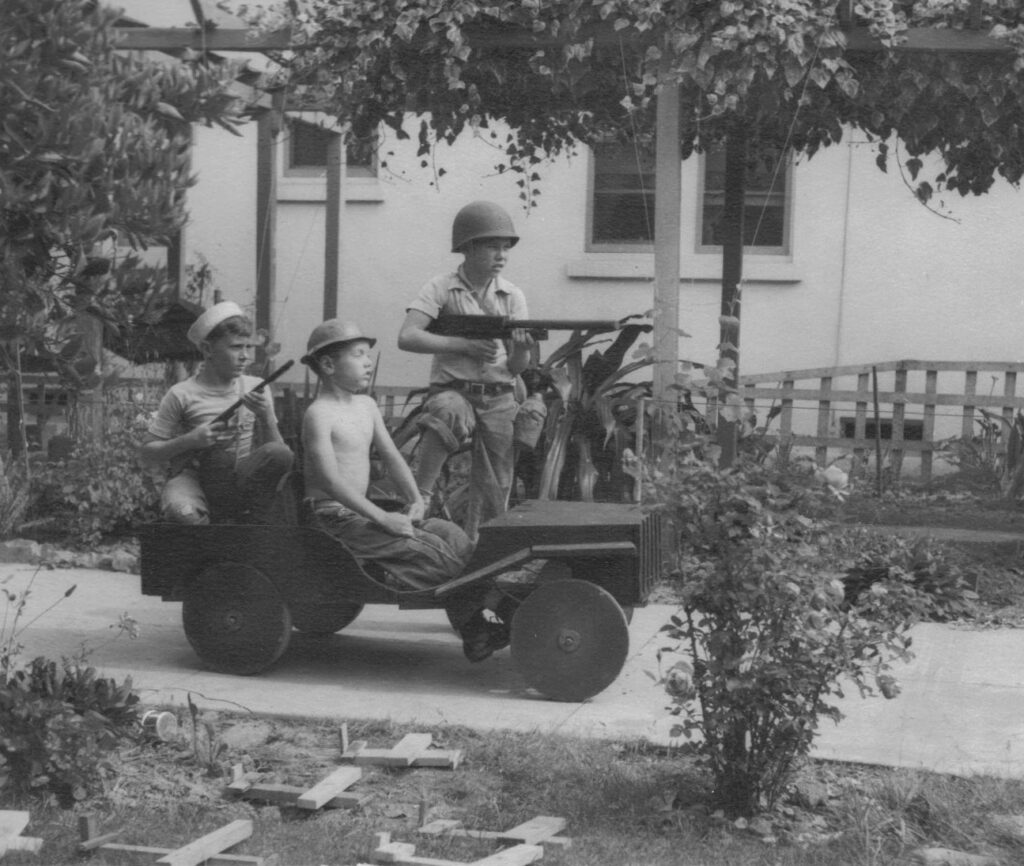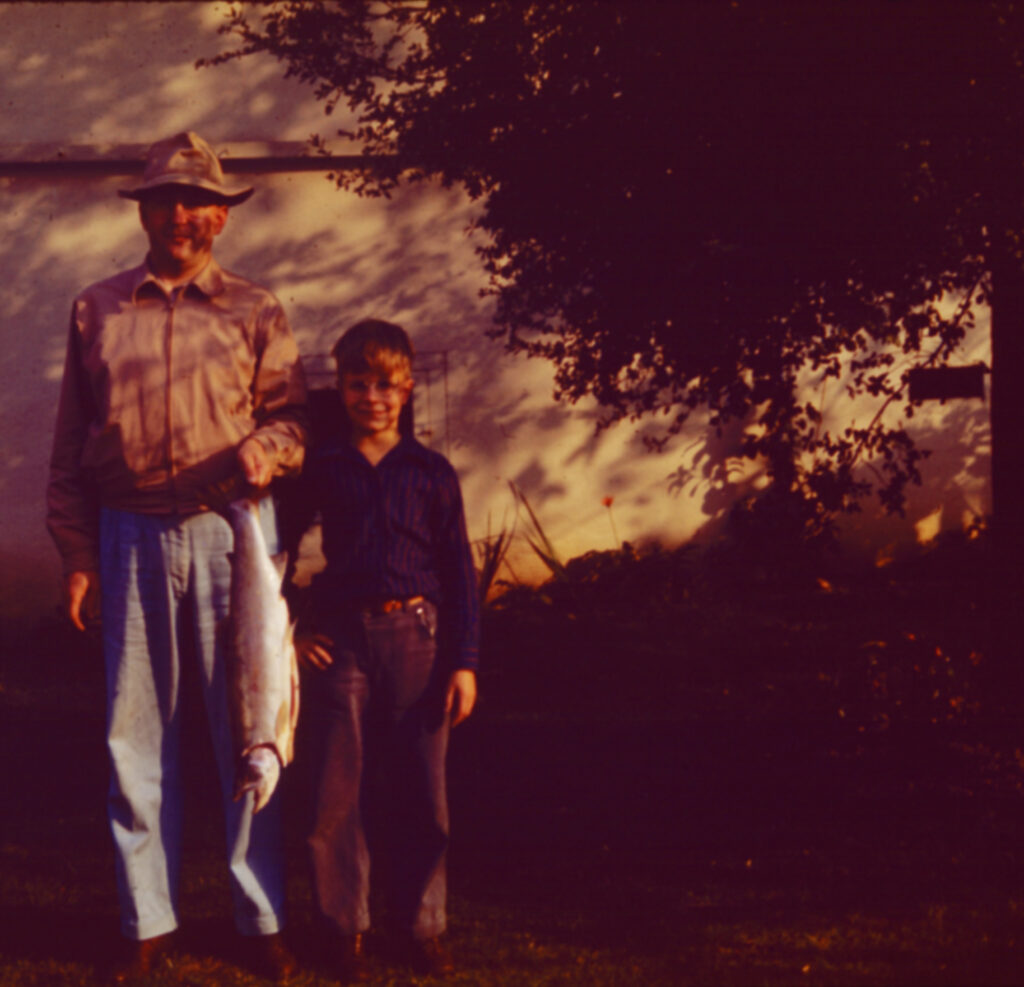Recollections of Bill Moffett as a kid during WWII: for his grandson and family (PART I) Written July 2017
Introduction: My dad and his family lived in California during WWII. This is a brief look at what life was like for a ten-year-old kid living there at the time. The story is split into two posts (Part I and II). Click this link for Part II.
Bill’s story:
Recently my grandson called to ask me what living was like when I was 10 years old. He was working on a Cub Scout project, so wanted me to keep it short. He gave me about two minutes to tell him a story and then said he’d had enough. There were so many things to tell him that I started to think maybe I should write some of my thoughts down, not just for him, but for our other grandchildren, too.
There was no TV, fast food, computers, tablets, cell phones, refrigerators, freezers, polio shots, credit cards, microwaves, and we had Dime stores where you could actually buy something for 5 or 10 cents and so many other things that I can’t even begin to list them, so I am just going to start and tell you how things were then (1943).
My country and the world were engulfed in war. What did that mean to me?
From the day following the Japanese attack on Pearl Harbor (December 7th 1941), all the energies of all the people of our (America) country were directly related to the war:
All men over 18 years old had to register for the war draft. Most were drafted within a few days or months of registration and were sent off to the Army and then on to the war front. If you didn’t want to go into the Army, then you could volunteer for the Navy, Marines, or Coast Guard. Those not physically qualified (4F) were put into essential jobs, replacing those who got drafted. A great number of the women went to work doing men’s jobs in construction, defense work, ship and aircraft building, and all sorts of other jobs formerly considered too hard for women. Married women were now allowed to become teachers. Before the war, only unmarried women could teach.
Lots of military and civilian officials believed that the Japanese would land their forces on our west coast and march into the middle of the country. This feeling was very strong when the Japanese invaded the Aleutian Island chain in Alaska, but fortunately that feeling was greatly reduced when the Allies won the battle for Midway Island. The victory cost the Japanese a lot of their Pacific fleet and our planners didn’t think they had the force left to invade the US mainland at that time.
Everything was rationed and most non-essential activities were restricted. I lived in South Pasadena, California, a suburb of Los Angeles, and we were under a total black out every night. There were no neon signs, or other outside lights and only about 1 in every 4 street lights were on and they had to have their top painted black. Few traffic signals of any kind worked. All the cars had the top half of their headlights painted black so that no light reflected upwards into the sky.
We had neighborhood Block Wardens who patrolled every night checking each house to make sure that no light escaped from the house. All the upper windows were painted black and all the rest of the windows had to have drapes covering up any light source. All areas had Air Raid Sirens and of course if one of those went off, you had to turn off all lights and sit in the dark. They ran practice alerts about once each week. I can remember several times that Japanese subs actually fired some rounds into Los Angeles harbor and all the sirens went off and we were convinced that we were really going to get it. We had some supplies in our basement so we could hide out if things got really bad, but we never used them.

My grandfather, who lived with us, had a hobby as a gardener and had a greenhouse in our back yard and raised orchids and other exotic flowers. He was surprised when several of his local gardening friends came by to tell him goodbye about two weeks before the attack on Pearl Harbor. They were all Japanese. How did they know?
During the war almost everything was rationed: Gasoline was perhaps the most wide spread item. You had to register all your cars and receive a rations rating for each one. The rating was recognized by a window sticker with letters A thru D. Everyone got at least an A rating which entitled the owner to 5 gallons per month. You had a folder in the car with little coupons for each gallon. If you had to drive to work in a Defense related job then you got a B sticker and maybe 10 gallons. Special needs and emergency services received more gas under either a C or D stickers. Agriculture received unlimited gas, but the gas they were given for their tractors and plows was colored purple and if you got caught with purple gas in your car it was a heavy fine in court. Purple gas burned with lots of exhaust smoke, so violators were easily spotted.
Gasoline was not the only hard to get item, tires were in really short supply. There just weren’t any to be had. And, of course, no new cars or trucks were manufactured between Dec 1941 and January 1946. All the car factories were used to make tanks and military vehicles. All the other big plants were for building aircraft. We had two cars throughout the war: a 1939 Plymouth coupe that my dad drove to work each day and a 1940 4-door Buick sedan that was mom’s car and provided the transport for the rest of the family. I had my bicycle which was my main means (outside of walking) of transportation. There was no “Mom, drive me to the movie or take me to the store or take me over to Al’s house.”
Most food was rationed, and each family received coupons for items such as: sugar, meat, eggs, butter, lard, chicken, fish, and there was no candy, cake, cookies etc. unless your mom had enough sugar to make some for you. Seeing as how most of the sugar was used to can fruits (apricots, peaches, cherries, apples, pears) there just wasn’t any sugar left over for treats. We had an apricot tree and a plum tree in our yard, and we tried hard to get them picked before the birds messed the fruit up. We all sat down each evening to eat and I learned that if I didn’t like what had been fixed, I could wait at the table until everyone else finished and then go to bed hungry. There just wasn’t any food to waste.
Each family had a Victory Garden where we tried to grow vegetables (potatoes, tomatoes, carrots, beans, lettuce and corn) in patches of ground not being used for some more important task. We were lucky because my dad bought the two vacant lots behind our house and we used those for our garden. Part of it was also used by some of the neighbors. I built a chicken house and fenced in some of the vacant lot for a chicken yard. I started out with 4 dozen chicks and as they grew, I kept one rooster and the hens. Soon I was feeding our family, and some of the neighbors, eggs and chicken pieces. Of course, they paid me and I was able to get chicken feed and keep the cycle going.
One of my most vivid memories that I have of that time was when my Granddad showed me how to kill a chicken so we could cut it up for food. I held it by the legs and put the head down on a stump and hit it with an axe to chop off the head. I did it, but I dropped the chicken and it went running around the yard without a head. Wow! I learned later that it was better to twist the neck.
Some of the things we had to do in the garden were far from big farm ways. For instance, we didn’t have any hives of bees in the area so in order to pollinate our tomatoes, we used small paint brushes and went from plant to plant touching blossoms with the brush. Mighty hard work on the back. We wanted to save the things we grew, so mom would either can them up or put them in the freezer.
Of course, we didn’t have freezers in our refrigerators, in fact we didn’t have refrigerators. We had ice boxes. They were boxes with several doors on the front and shelves on the inside. The biggest shelf held a big block of ice (a cube about 14 inches on a side). The ice was delivered twice weekly by a guy with a truck from the ice plant, who carried these cubes into the house on his back, held with a big pair of tongs. We were able to rent space in the freezers at the ice plant. So, we had a locker there and put in whatever extra fruit or vegetables we could. Dad was also able to get some beef from our cousins in Oregon when we went there to work on the gold mine. Since we got it directly from the farmer, it didn’t count against us in rationing. So, we got the meat cut up and put in the freezer locker.
Mom did all our baking for us. She made our bread, rolls, etc. all from scratch. There were no ready mixes available. Again, since we had sugar rationing, we rarely had jam or jelly to put on our bread or toast. We couldn’t get butter, but you could get a sort of diluted fat mixture that came with a tube of yellow food coloring and you could mix it together and get a mixture that looked like butter. Of course, it didn’t taste great.
There was only a very limited number of what you could call restaurants. And they required ration tickets for just about anything that you ate. There definitely were no McDonalds, pizza shops or “fast food” places to eat. We did make a lot of our own ice cream by churning it by hand after mom made up the mix. We would sit around after dinner and take turns on the crank for the ice cream. It was really good. The restaurants that there were, mostly served travelers or out of town workers, with no other place else to go.
My bicycle got used for another important job. I had a paper route and every evening Monday–Saturday I delivered about 50 papers to houses in our area. The papers came to me every afternoon in a big stack and I would have to separate them and then fold them so I could throw each one into peoples’ yards or onto their porches. We didn’t have plastic to keep them dry or rubber bands to hold them together, so on wet days I had to take each one up the people’s front doors so the paper would stay dry. Saturdays, I had to go to each house to collect money for that week’s papers. The bill was usually about 1 dollar for the week and if I was really lucky maybe they would tip me a dime. Again, there was no help from Mom with the car and on wet days I just had to cover up and try to keep the papers dry.
[End Part I by Bill Moffett] Click here for the Rest of the Story- Part II


One comment